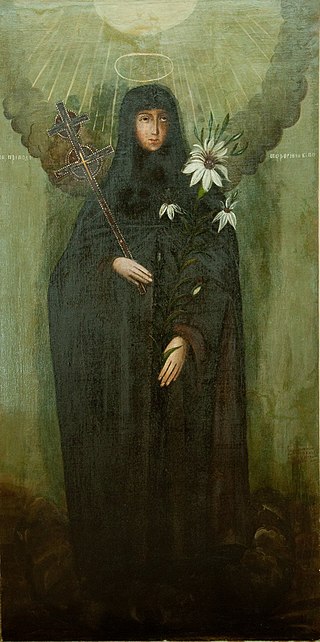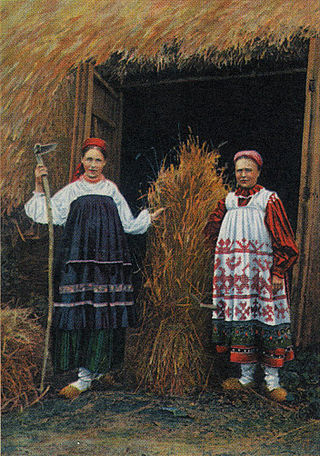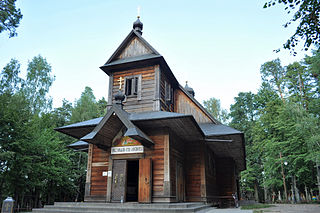
Euphrosyne of Polotsk was the granddaughter of a prince of Polotsk, Vseslav, and daughter of Prince Svyatoslav-Georgy Vseslavich. She has long been a popular saint among Orthodox devotees, particularly those in Belarus, Ukraine, and Russia with a traditional feast day of May 23. In addition, since 1984, she has been one of the 15 patron saints of Belarus, whose lives are celebrated in the Belarusian Orthodox Church, on the first Sunday after Pentecost.

In the Christian liturgical calendar, there are several different Feasts of the Cross, all of which commemorate the cross used in the crucifixion of Jesus. Unlike Good Friday, which is dedicated to the passion of Christ and the crucifixion, these feast days celebrate the cross itself, as the sign of salvation. In Western Catholicism, Eastern Catholicism, Eastern Orthodoxy, Oriental Orthodoxy, Lutheranism and Anglicanism the most common day of commemoration is 14 September, or 27 September in churches still using the Julian calendar.

The Nativity of the Blessed Virgin Mary, the Nativity of Mary, Marymas or the Birth of the Virgin Mary, refers to a Christian feast day celebrating the birth of Mary, mother of Jesus.

The Feast of the Transfiguration is celebrated by various Christian communities in honor of the transfiguration of Jesus. The origins of the feast are less than certain and may have derived from the dedication of three basilicas on Mount Tabor. The feast was present in various forms by the 9th century, and in the Western Church was made a universal feast celebrated on 6 August by Pope Callixtus III to commemorate the raising of the siege of Belgrade (1456).

July 31 - Eastern Orthodox liturgical calendar - Aug. 2

August 5 - Eastern Orthodox liturgical calendar - August 7

George's Day in Spring, or Saint George's Day, is a Slavic religious holiday, the feast of Saint George celebrated on 23 April by the Julian calendar. In Croatia and Slovenia, the Roman Catholic version of Saint George's Day, Jurjevo is celebrated on 23 April by the Gregorian calendar.

The Intercession of the Theotokos, or the Protection of Our Most Holy Lady Theotokos and Ever-Virgin Mary, is a Christian feast of the Mother of God celebrated in the Eastern Orthodox and Byzantine Catholic Churches on October 1 . The feast celebrates the protection afforded the faithful through the intercessions of the Theotokos.

First Fruits is a religious offering of the first agricultural produce of the harvest. In classical Greek, Roman, and Hebrew religions, the first fruits were given to priests as an offering to deity.

A Paraklesis or Supplicatory Canon in the Byzantine Rite, is a service of supplication for the welfare of the living. It is addressed to a specific Saint or to the Most Holy Theotokos whose intercessions are sought through the chanting of the supplicatory canon together with psalms, hymns, and litanies.
Church of Our Saviour, Church of the Savio(u)r, Church of Our Merciful Savio(u)r, or variations thereof, may refer to many Christian churches dedicated to Our Saviour, including:

In Ukraine, Christmas celebrations traditionally start on Christmas Eve, which is celebrated from December 24 to January 6, the date of the celebration of the baptism of Jesus, known in Ukraine as Vodokhreshche or Yordan, according to the Gregorian calendar and Revised Julian calendar by the Orthodox Church of Ukraine (OCU), the Catholic Church in Ukraine and Ukrainian Protestants.
The following are 11 public holidays in Ukraine.

Feasts of Jesus Christ are specific days of the year distinguished in the liturgical calendar as being significant days for the celebration of events in the life of Jesus Christ and his veneration, for the commemoration of his relics, signs and miracles. While Easter is treated everywhere as the central religious feast in the Christian liturgical year, the other feasts differ in the liturgical practice.

Dożynki is a Slavic harvest festival. In pre-Christian times the feast usually fell on the autumn equinox, in modern times it is usually celebrated on one of the Sundays following the end of the harvest season, which fall on different days in different regions of Europe.

Siberian Baroque is an architectural style common for ambitious structures in 18th-century Siberia, where 115 stone churches in Siberia were recorded in 1803, most of which were built in this provincial variant of the Russian Baroque, influenced by the Ukrainian Baroque and in some cases even incorporating lamaist motifs. Most of the buildings were preserved in Irkutsk, Tobolsk and Tomsk. An original interior of a Siberian Baroque structure survives only in the Feast of the Cross Church in Irkutsk.

The Honey Feast of the Saviour or Wet Saviour known as the Honey Spas is the First Saviour Day of a triduum in honor of the Saviour, celebrated on August 1 in the Julian calendar which corresponds to August 14 in the Gregorian calendar. It is followed by the Apple Feast on August 6 and the Nut Feast of the Saviour on August 16 in the Orthodox calendar. On that day, the Orthodox Church honors the memory of three shrines: the Life-Giving Cross of the Lord, the image of the Savior and the icon of the Virgin of Vladimir. It is also the first day of the Dormition Fast. There are usually processions and water blessings on the rivers, during which people and cattle bathe in the consecrated water, and wells are consecrated.

The Nut Feast of the Saviour is the third spa feast of the Saviour which celebrates the Holy Mandylion of the Lord. It is celebrated as the afterfeast of the solemnity of the Dormition. After the Honey Feast of the Saviour and the Apple Feast of the Saviour, the Nut feast is therefore placed on August 16 in the Julian calendar and on August 29 in the Gregorian calendar.

Grabarka Holy Mount is a mount located next to the village of the same name in the Nurzec-Stacja Commune, Siemiatycze County, Podlaskie Voivodeship in eastern Poland. It is the most important place of religious worship for Orthodox believers in Poland. The complex includes nunnery of Saints Martha and Mary, established in 1947, as well as three monastery churches. The main monastery church, the Transfiguration of Jesus Christ Church is also a parish church. The monastery, Orthodox churches and two Pilgrim Houses make up the Grabarka-Klasztor settlement. There is also an Orthodox cemetery in the settlement. The complex has 9 ha.





















